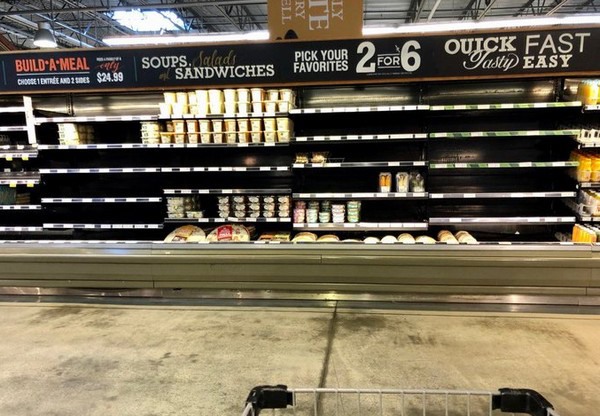There’s a perfect storm across North America that has led to some of the empty shelves consumers are seeing at their local retailer.
COVID of course continues to be a significant factor contributing to the issue. “The recent Omicron surge has further enhanced the existing labor shortage,” says Brad Rubin, an industry advisor, food & agribusiness with San Francisco, CA-based Wells Fargo. “As workers call in sick across the supply chain, transportation, and product movement also slow down. With a just-in-time inventory system, that can create supply problems.”
And then there’s the weather. Winter weather conditions across the Midwest and Northeast are also creating challenges for keeping items stocked on grocery store shelves. “On top of these macro issues, a major bagged salad producer had several SKUs recalled for bagged salads and leafy greens after concerns of listeria contamination,” adds Rubin.
As he notes, the supply chain is at the mercy of both the weather and the virus. “As long as labor challenges continue, transportation costs will get more expensive as freight companies look to pay higher wages to attract a workforce that can fulfill their contracts,” says Rubin. “If the virus continues to keep laborers from harvesting product, processing protein, or shipping goods, then these issues will continue on a longer-term basis. My hope is that we are more back to normal by spring.”
 “If the virus continues to keep laborers from harvesting product, processing protein or shipping goods, then these issues will continue on a longer-term basis. My hope is that we are more back to normal by spring," says Rubin.
“If the virus continues to keep laborers from harvesting product, processing protein or shipping goods, then these issues will continue on a longer-term basis. My hope is that we are more back to normal by spring," says Rubin.
The role of imports
This time of year of course is a factor too. “Most fruits and vegetables are produced between May and October in the U.S., so in the winter months, the supply is imported,” says David Branch, also an industry advisor, food & agribusiness with Wells Fargo. “Of the $14 billion of fresh fruit imported in 2019, approximately half came from Mexico while a quarter of the $9 billion fresh vegetable imports came from Mexico.”
Of course, while the majority of imports from Mexico are trucked into the U.S., the remainder largely arrives by ship. “Given the increasing problems with port congestion on both the West and East coasts, coupled with continued trucking/labor issues, there is a continued impact on U.S. supplies of fresh produce,” says Branch.
He also adds that two-thirds of the U.S.’ fresh fruit and one-third of its fresh vegetables are imported. “This level of imports, respectively, are driven primarily by year-round demand for fresh produce coupled with the fact that the U.S. can’t grow some fruits and vegetables commercially, such as bananas and other tropical fruits, and must be imported,” adds Branch.
 Left to right: Brad Rubin, David Branch
Left to right: Brad Rubin, David Branch
Hoarding on the way?
So does this mean we’ll see those early pandemic shopping practices of hoarding products? Not necessarily, particularly since retailers learned from what happened in those early, challenging days in the spring of 2020.
“Some stores are implementing purchase limits. For example, Costco is limiting the amount of certain products that consumers can purchase,” says Rubin. “In other areas, like California, produce is more readily available because a lot of it is grown in the state. But stores are getting limits from their suppliers so consumers need to shop earlier in the morning to get what they desire. I think we are further from a hoarding scenario than most people think. There is plenty of product and food available in the system. Right now, the transportation and the labor required to transport food, is the major issue.”
This also means that consumers may see some other items filling up those shelves. “As for stores supplying product, the key is based on how creative brands can get with regards to buying and acquiring product,” says Rubin. “Diversification with product sourcing is a sound business strategy so I would look for some of the larger grocery chains to mitigate their risk with a supply strategy that helps ensure more product for consumers.”
 For more information:
For more information:
Sarah Hatch
Wells Fargo
sarah.hatch@wellsfargo.com
https://www.wellsfargo.com/
